Inventions
Tuberosity Meter
In 1960, Thomas Scoville received a patent for a device for measuring tuberosity. He explained that the purpose of measuring tuberosity was to improve the fit of chairs:
Even after looking up the meaning of the word 'tuberosity' in the dictionary, it took me a while to figure out what exactly Scoville's device was measuring, and what it possibly had to do with chairs. Because the dictionary simply defined tuberosity as a 'rounded swelling.' Some more googling revealed that Scoville must have been referring to the Ischial tuberosity, or 'sitting bone'. As defined by wikipedia, this is:
Posted By: Alex - Sun May 24, 2020 -
Comments (1)
Category: Body, Furniture, Inventions, Patents, 1960s
Frederick Newbery’s long-distance milk pipes
Frederick Newbery envisioned pipes transporting milk underground from farms directly into cities. He received a patent for this idea in 1874 (No. 148,620). Though as far as I know, his long-distance milk pipes were never put into practice.
Posted By: Alex - Sun May 17, 2020 -
Comments (3)
Category: Inventions, Patents, Nineteenth Century
Exercise Wings
Richard Burgess's 1941 patent (No. 2,244,444) describes a pair of feathered wings that could be attached to the arms of an individual, who would then flap the wings up and down. This, claimed Burgess, would create a sense of buoyancy, while simultaneously providing physical exercise. In particular, it would "develop the chest, back, arm and leg muscles, while also tending to create accelerated breathing and thus general physical tone." It would do all this, he said, while also being "very diverting and accordingly attractive."How did this product never take off?

Posted By: Alex - Sun May 10, 2020 -
Comments (0)
Category: Exercise and Fitness, Inventions, Patents, 1940s
Water-Dispensing Furniture
Thomas Mullenaux of San Pedro, CA was recently granted a patent (No. 10,626,581) for furniture that gathers water from the air via a dehumidifier, collects it in a built-in reservoir, and then allows a person to drink it through a retractable hose.However, in his patent application, Mullenaux never explains why anyone would want or need 'water-dispensing furniture'. I guess it might be useful for those who are too lazy to walk to their kitchen to get a glass of water.


Posted By: Alex - Sun May 03, 2020 -
Comments (2)
Category: Furniture, Inventions, Patents
Informative Swimwear
In 2005, Robert Dickey and Ruth Stephens filed a patent application for "swimwear as information device." Their idea was to make a line of swimwear that displayed maritime signal flags. This would allow people to communicate messages to those around them via their swimwear. They explained:The possible messages one could send seemed limitless, but they were never granted a patent. Perhaps the idea of messages on clothing was deemed too obvious.
There's also the limitation that only people conversant with maritime signal flags could decode the messages, which would make the various 'stay away' messages somewhat pointless.
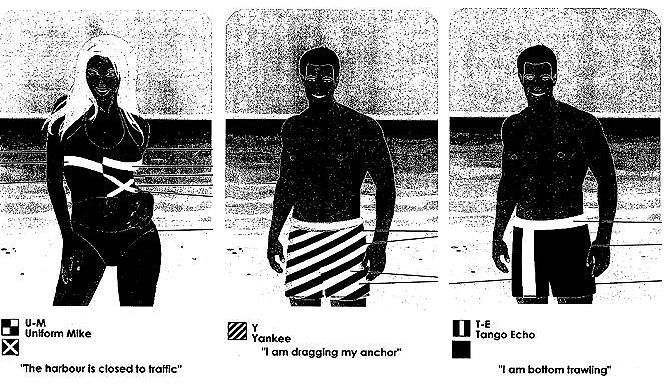
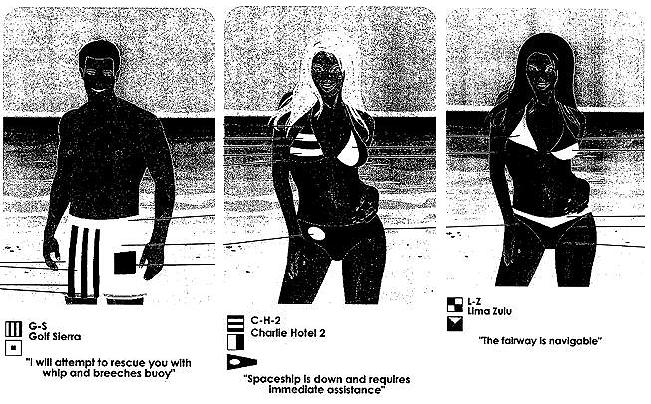
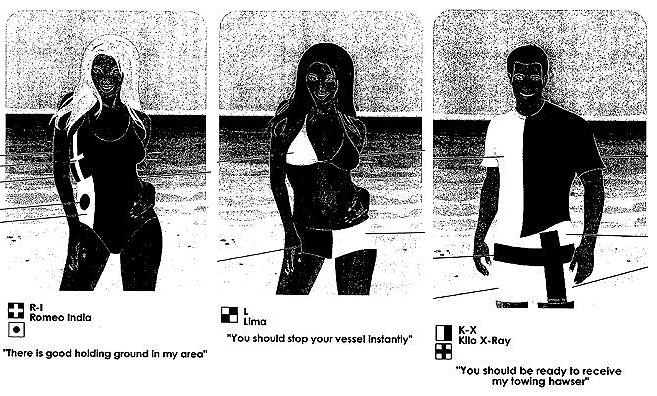
Posted By: Alex - Sun Apr 26, 2020 -
Comments (3)
Category: Boats, Fashion, Inventions, Patents, Languages, Double Entendres and Nudge-Nudge, Wink-Wink
Five Weird Bikes
Narration not in English, but unnecessary for enjoyment.
Posted By: Paul - Sun Apr 26, 2020 -
Comments (0)
Category: Bicycles and Other Human-powered Vehicles, Inventions
Canned Sunshine
The idea of using sunlight to kill viruses inside the body has recently been in the news. That made this old invention I posted about last month seem topical.Edward W. Boersteler, of Watertown, MA, was the inventor of the ‘Curay Light Applicator,’ aka ‘Canned Sunshine.’ Back in the 1920s and 30s, he marketed it as a cure for the common cold. It emitted ultraviolet light, which people were supposed to shine down their throats, killing the germs.
In the selection of text below (taken from an article in the Chilicothe Constitution Tribune - Oct 16, 1925), I didn't correct any of the misspellings. In particular, I wasn't sure whether the phrase "ultra violent light" was a mistake, or intentional.
“Fused quartz transmits ultra violent or invisible light without loss, whereas ordinary window glass shuts out ultra violent light which is the curative agent in sunshine.
“In the Curay Light aplicator,” Boerrsteler continued, “we have produced a source of radient energy closely approximating concentrated sunlight in the upper altitude, with an equivalent ultra violent content. Though it is a potent germ killer, it is harmless to the cels of the body.

image source: Harvard University Collection of Historical Scientific Instruments

Chilicothe Constitution Tribune - Oct 16, 1925
Posted By: Alex - Fri Apr 24, 2020 -
Comments (4)
Category: Health, Inventions, Cures for the common cold, 1920s
Left-Foot Accelerator
Deadly crashes guaranteed, or your money back!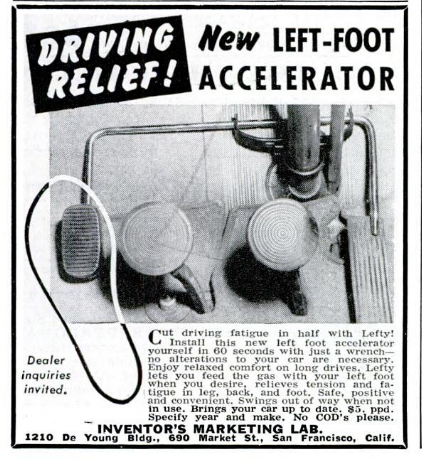
Source.
Posted By: Paul - Wed Apr 22, 2020 -
Comments (1)
Category: Death, Inventions, 1950s, Cars
The Tummy Tutor
It also went by the name "Belly Beeper". The idea was that if you slouched or let your stomach out, it would start beeping. Supposedly this would train you to always keep your stomach muscles tensed and not slouch.Either that or it would train you to avoid wearing it.
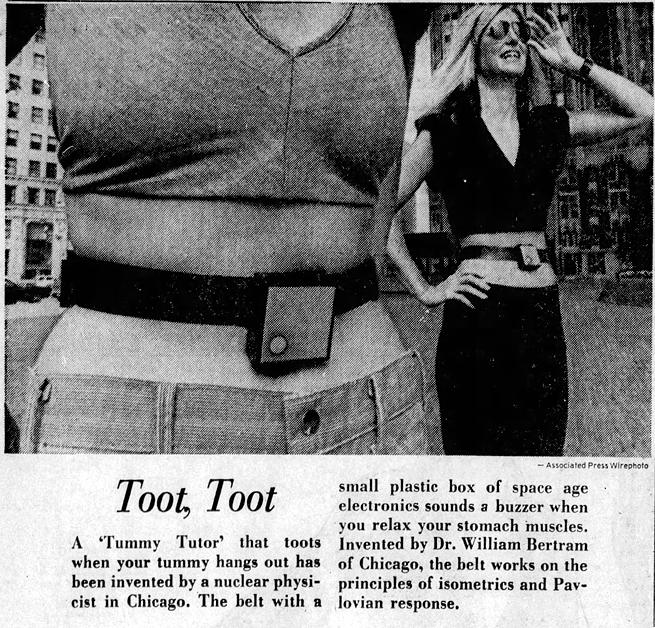
The Miami Herald - Oct 7, 1973
Posted By: Alex - Tue Apr 21, 2020 -
Comments (2)
Category: Inventions, 1970s, Dieting and Weight Loss, Stomach
Clean Hands Assured
Claude Davis of Melbourne, Florida obtained a patent for this curious device in 2000. It seems newly relevant in the era of coronavirus.The gadget attached to bathroom doors. Whenever someone turned the handle to open the door, the gadget would spray their hand with dye. This, reasoned Davis, would encourage people to wash their hands, to remove the dye. He imagined his invention might be useful in restaurants and hospitals that have "statutory type hygiene requirements to have their staff and employees clean their hands after using restroom facilities."

Although the invention had good intentions, I can think of several problems with it.
First, I'm sure that most employees would find it incredibly obnoxious to have their hand sprayed with dye every time they went to the bathroom.
Second, wouldn't the gadget also spray dye whenever someone exited the door... spraying into empty air? In which case, half the dye would be wasted. I can imagine employees standing on the inside of the door, pumping away at the door handle until all the dye was used up.
Posted By: Alex - Sun Apr 19, 2020 -
Comments (2)
Category: Bathrooms, Hygiene, Inventions, Patents

| Who We Are |
|---|
| Alex Boese Alex is the creator and curator of the Museum of Hoaxes. He's also the author of various weird, non-fiction, science-themed books such as Elephants on Acid and Psychedelic Apes. Paul Di Filippo Paul has been paid to put weird ideas into fictional form for over thirty years, in his career as a noted science fiction writer. He has recently begun blogging on many curious topics with three fellow writers at The Inferior 4+1. Contact Us |




